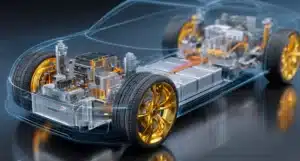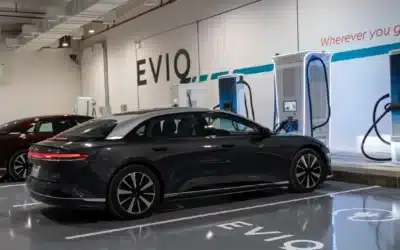‘The bearings need replacing, head gasket’s blown, injector valves are seized and your big end’s going to need some attention.’ Mechanical gobbledygook?
Many a motorist has found themselves bamboozled by nefarious mechanics who enjoy waving a long list of technical faults in your face, at the end of which usually resides a very big and scary bill.
Truth be told, there are as many as 2000 moving parts on a traditional Internal Combustion Engine car (ICE). That’s 2000 things that can wear out, break or just stop working.
By contrast, the drivetrain in an electric vehicle (EV) usually has around 20 moving parts or less, primarily consisting of the electric motor and drivetrain. But does that make an electric car cheaper and simpler to run and maintain?
It’s been found that service and maintenance costs on an EV can be up to 23% lower when compared to an ICE car over three years. Servicing costs alone could be slashed by half compared to a conventional petrol car.
However, electric cars are not without their needs. Here’s what you need to know when it comes to running and maintaining an EV.
How often does an EV need servicing?
Like all cars, electric cars also need servicing. At the very least, safety-related items such as brakes, tyres and suspension need to be inspected regularly, and a diagnostic computer should be plugged in to detect any fault codes that need attention.
Nonetheless, not only are servicing costs significantly reduced, but service intervals tend to be longer; typically, you’re looking at visiting the garage once every two years, or within 20-30,000km depending on manufacturer’s recommendations. Some EVs such as Teslas or the BMW i3 for example, have ‘condition-based’ intervals and the onboard computer will alert you when servicing is required.
The batteries
EV sceptics are often very concerned about the robustness of battery packs, however real-world usage has shown EV batteries to last well beyond 10 years and 150,000km. Battery degradation on a newer EV should not be a concern, as they come with at least an 8-year warranty (as mandated in America). Over time, individual cells might degrade or stop working, and it’s possible in some cases to just replace those sections rather than an entire battery pack (which can cost up to $20,000).
You can lengthen your battery life by following a few simple tips:
- Keep your battery charged to a minimum level of 20% and avoid letting it discharge completely. Ideally charge it only to 80% rather than 100% to ensure your battery’s longevity.
- Use the correct charging cables and compatible charger/charging station.
- Battery packs are cooled either using air or, more commonly on the latest EVs, by liquid. The cooling liquid should only be checked by an authorized technician as it is in a sealed container and should not need replacing or topping up.
- Like conventional cars, there is also usually a regular 12-volt car battery that powers peripherals such as the locking systems and infotainment. This usually needs replacing every three to five years.
The drivetrain
Electric motors need little to no maintenance. Even the gearbox is a far simpler set-up, usually with just a single ratio. While the transmission does use oil that might require changing, on newer EVs this is an advanced synthetic oil and the transmission units are thus effectively sealed for life.
Mechanics will also inspect and check the bright orange high voltage electric cables, but these heavy-duty items are well protected and usually present no issues.
The brakes
It’s often suggested that because electric cars tend to be heavier than conventional cars, the brakes take more of a pounding and hence suffer more frequent wear and tear. In fact, the reverse is true.
Electric cars employ regenerative braking, where the electric motor becomes a generator converting kinetic energy back into electricity to charge the batteries. Effectively this means the resistance from the electric motor itself is doing most of the braking.
As such, wear on brake pads and discs is reduced significantly. Some service technicians have actually found the brakes on EVs to be seized from lack of usage!
Eventually of course pads, discs and brake fluid will need to be changed.
The tyres and suspension
Another misconception is that the extra mass of an EV dramatically increases tyre wear. This could be the case if conventional tyres are used, but electric cars are fitted with specialist EV tyres. These are specifically designed to manage the extra weight thanks to stronger sidewalls. They also boast lower rolling resistance, are quieter and offer better grip to cope with the instantaneous acceleration many electric cars are capable of.
EV-specific tyres are usually around 80% more expensive, and some owners might have replaced them with cheaper conventional alternatives. This is a false economy and potentially dangerous as they could have reduced braking performance, increased wear and might be more prone to blow-outs.
Top tips for EV tyre maintenance:
- Check the tyre pressure regularly and keep them inflated to recommended levels. Under-inflated tyres reduce the efficiency and therefore range of the car.
- Inspect the tyres once a week for damage to the sidewalls and wear on the tread. Minor damage, spotted early, can be repaired and will save you money as a replacement tyre is expensive.
When it comes to the suspension, the extra mass being carried around could wear out springs and dampers more frequently, so these should be checked during routine maintenance.
The oily bits and everything else
As already mentioned, there will be oil in the transmission and possibly coolant for the batteries, but these will need little or no attention.
Even so, there are other consumables that could need replacing or replenishing, such as cabin filters, the air-conditioning’s refrigerant and pumps, and windscreen washer fluid along with wiper blades etc.
Who should work on your EV?
While EVs are relatively straightforward engineering, they can be dangerous to work on due to the high voltages present and the complexity of the electrical systems.
This means that only professionally trained technicians should work on the car, and in most cases, this will mean taking it back to the main authorized dealer.
Having said that, as the number of EVs on the road start to increase, independent specialists are starting to pop-up. Always enquire to make sure they have certified EV-qualified technicians to work on your car – for their safety as much as yours.
However, if they tell you the ‘head gasket’s blown’ you’re at the wrong place!











